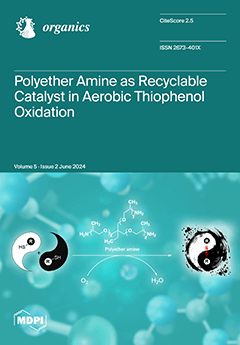Recently, the construction of the trisubstituted olefin-type probe molecules has elicited the attention of many researchers. However, the synthesis of the trisubstituted olefin-type probes containing two
N-heterocycles simultaneously has been rarely reported. In this study, starting from the inexpensive mucobromic acid
1
[...] Read more.
Recently, the construction of the trisubstituted olefin-type probe molecules has elicited the attention of many researchers. However, the synthesis of the trisubstituted olefin-type probes containing two
N-heterocycles simultaneously has been rarely reported. In this study, starting from the inexpensive mucobromic acid
1 and
N-heterocyclic compound
2, we first utilized a simple one-step reaction to synthesize a series of trisubstituted olefin-type compounds
3 simultaneously bearing with the structure of two
N-heterocyclic rings in the absence of transition metal catalysts with a yield of 62–86%. The optimal reaction conditions were systematically explored, and the structure of the obtained compounds
3 were well characterized with
1H NMR,
13C NMR, X-ray single-crystal and HR-MS. The preliminary observation showed that, in the presence of base, mucobromic acid
1 reacts as its ring-opening structure, and the successive nucleophilic substitution reaction and Michael addition reaction can generate the target product
3. Considering that the aldehyde group in the molecular structure of the trisubstituted olefin-type compounds
3 may react with malononitrile, we carried out some relevant investigations so as to realize the visual detection of malononitrile. Interestingly, among the products, compounds
3a–
3c can be prepared in portable test strips through a simple process and used to achieve the naked-eye detection of malononitrile in environmental systems as designed.
Full article





